PinotFile: 6.30 June 17, 2007
|
Gnarly Pinot From Down Under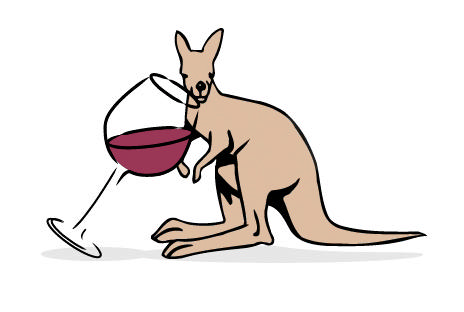 ... Thomas George Shaw, Wine, the Vine, and the Cellar 1863
Pinot Noir has historically been pretty much an afterthought, even though Pinot Noir has been grown in Australia since the 1830s, much longer than in many parts in the wrong places (too warm - sound familiar?). There was a movement during the ’70s and ’80s to cooler climates at a time when California was beginning to realize that Pinot Noir prospered best in chilly environs. There were sporadic successes - a 1976 Tyrell Pinot Noir came in first in the Pinot Noir class at the 1979 Gaul-Millau Wine Olympiad - but the wines often were unflattering to this most sensual of grapes. Some of the iconic Australian Pinot Noir labels such as Bannockburn, Bass Philip, Giaconda and Mount Mary were inconsistent and as writer Harvey Steiman said, “they seem to go for earthy complexity early on that makes some vintages downright weird.” A quiet revolution is now in progress in the cool climate regions of southern Victoria (southeast Australia) as dedicated winegrowers are beginning to craft Pinot Noirs that are downright gnarly (Aussie slang for terrific). Victoria has a colorful history of grape growing that mirrors the historical events in California. The first plantings were in 1834 using vines brought in to the region from Tasmania. Gold was discovered in 1851 which led to a boom in vineyard plantings. By 1890, Victoria produced more than 50% of Australia’s wine. Part of the annual output of wine was blended together and shipped abroad under the name of “Australian Burgundy.” Phylloxera was first discovered in the region in 1875, and by 1910, had thoroughly decimated the wine industry. Recovery was spearheaded by fortified wines which accounted for 80% of all Australian production. The ’70s and ’80s saw a proliferation of plantings of the classic French varietals including Syrah (Shiraz is the preferred Australian term), Cabernet Sauvignon, Merlot, Pinot Noir and Chardonnay.
Like California and Oregon, the Australians are now using modern viticultural techniques for Pinot
Noir and handling it with respect and gentleness in the winery. Pinot Noir has found a home in appropriate
microclimates throughout Melbourne’s ’Dress Circle,’ the so-called Port Phillip Zone of Victoria
(refer to map). This includes the Yarra Valley, Mornington Peninsula, Geelong, Macedon Ranges and
Sunbury. Still other regions of Victoria such as Gippsland Zone and North East Victoria Zone show
promise.
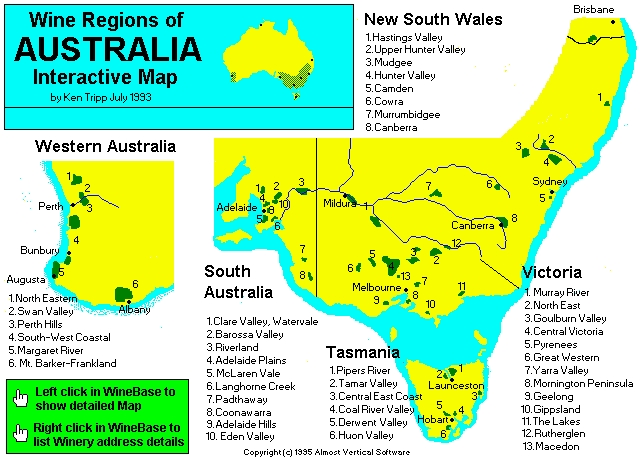 Some of the areas are continental with large diurnal variations in temperature during the latter stages of the growing season (Yarra Valley and Gippsland), and others have more maritime influence such as Geelong and the Mornington Peninsula. Within regions, the heat summation can vary a great deal (parts of Geelong and the Yarra Valley can ripen Cabernet!). The same clone of Pinot Noir can ripen up to five weeks apart depending on where it is located. Soils range from sandy/brown loam to rich, red volcanic. The volcanic or granite-based soils tend to lend more vigor to the vines. There are parts of Geelong that have limestone below red volcanic soil. Growing season sunshine hours (daylight hours with temperature between 59°F and 77°F) compare favorably with Burgundy (Mornington Peninsula 1420, Yarra Valley 1490, Cote d’Or 1449, Central Otago 1388, Willamette Valley 1660, Russian River Valley 2118,).
Most Pinot Noir vines are planted on their own roots. If rootstocks are used, Schwartzman and SO4 are common. In Australia, there are 16 significant clones of Pinot Noir planted, of which the most common is MV6. MV6 is known as the “Mother Clone,” and was originally taken from Clos Vougeot. and has a floppy canopy, rarely over crops, small bunches and berries, concentrated plumy and meaty characters, and great structure as a foundation clone in a blend. Other clones include D2V5 (UC Davis origin, aka 1A), D5V12 (UC Davis origin, aka 20), G5V15 (UC Davis origin, aka D2V6, 8048, the same as Wädenswil or 2A)), G8V3 (UC Davis/Swiss origin, aka 13), G8V7 (UC Davis origin, aka 15), H7V15 (UC Davis origin, 22), Mariafeld (Swiss origin, aka 14), 18GM (German origin, 13), Pommard (UC Davis origin, aka 5 and 6), Dijon clones 114, 115, 386, 521, 667 and 777 (Dijon/Morey St. Denis origin). The Davis clones were used in many early Pinot Noir vineyards. D5V12 was widely planted as a sparkling wine clone. It crops high and often lacks the flavor of other clones. It does well in warmer parts of the Pinot Noir growing regions when cropped below 2 tons per acre. The Dijon clones make up most of the newer plantings. 667 is just beginning to appear and 777 is the most recent and the rarest. Trellising is most often vertical shoot, although quite a few growers employ some form of Lyre or Scott- Henry. (see trellising types for Pinot Noir on page 4). Yields vary from 1.1 tons per acre to 5 tons per acre in the irrigated parts of the state. Most vineyards are between 2 and 3 tons per acre. Very little irrigation of any sort is used once the vines are established. This promotes a deep root system which is essential for vine survival and required to produce the flavors of fine Pinot Noir. Few producers use biodynamic principles. The biggest challenges to growing Pinot Noir are birds (netting is required), cool snap at flowering that gives a poor fruit set, frost in some regions and rain at harvest. Many of the vineyards are in former apple orchards, so the Light Brown Apple Moth and its larvae are a problem. Copper, sulfur and Scala are used to protect against botrytis. Most growers use one or two sprays of under-vine Roundup. Some have experimented with soil tillers to replace Roundup and some are using hay, but the recent drought (as of mid-May, 2007, the 12 month rainfall was the lowest in Victoria since they began keeping records in 1855) has meant most of the hay is allocated to feeding livestock. With small producers, most of the vineyard work is hands-on by the owners including pruning, trimming, leaf pulling, shoot thinning and spraying. In many intermediated-sized vineyards, teams of immigrants from Asia are used. Harvest runs from the end of March to early June. 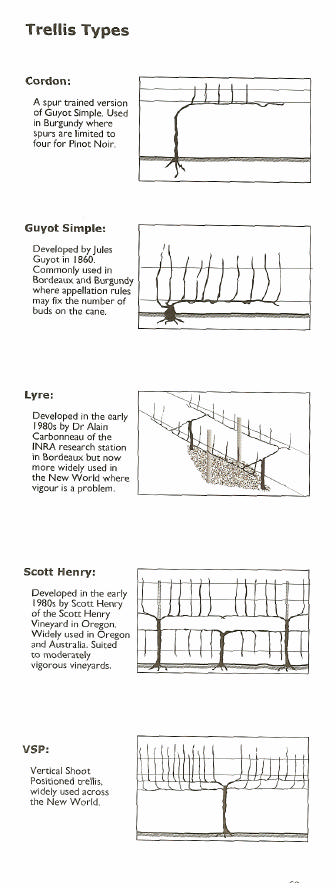 About 50% of all Pinot Noir produced in Australia is sold directly to consumers at the winery or through a mailing list, with the balance evenly divided between restaurants and wine shops. Precious little of Australia Pinot Noir is exported to the United States (see page 8).
Yarra Valley Some wine critics consider the Yarra Valley too hot for growing Pinot Noir. The wines can exhibit baked or stewed fruit flavors. Years ago, my first introduction to Australian Pinot Noir was the Yarra Yering Pinot Noirs, which definitely verified this criticism. Coldstream Hills: Co-founded in 1985 by noted Australian wine writer, James Halliday, this winery pioneered Pinot Noir in the Yarra Valley. The winery was sold to Fosters in 1996. Halliday lives on the property and is actively involved. De Bartoli, Diamond Valley (David and James Lance), Domaine Chandon (the French have considerable investments in Australian wine country), Evelyn County (James Lance), Hillcrest (Phillip Jones), Metier (Martin William MW), Mount Mary, Rochford’s Eyton (David Creed), Tarra Warra Estate, Wanitime (Reg and Maryann Egan), Yarra Burn, Yarra Ridge, Yarra Yering, Yering Station, and Yeringberg (Guill de Pury). (Winemakers in parentheses). Geelong This region is a difficult area to farm grapes due to the constant threat of drought, compacted soil, wind and spring frosts. 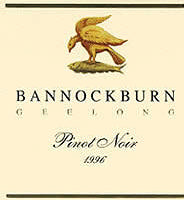 Curlewis, Innisfail (Nicolas Farr), Provenance, Scotchman’s Hill Macedon Ranges The Macedon Ranges are less than an hour’s drive northwest of Melbourne at the foothills of the Great Dividing Range. Rainfall is moderate and the volcanic soils are well-drained. 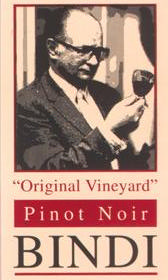 Curly Flat: Phillip Moraghan founded this winery in 1991. He has done several vintages in the United States, including Ponzi Vineyards in the Willamette Valley. A Pinot Noir specialist, his wines are highly praised and often the equal of Bindi. The estate vineyard is 33 acres and production is 3,500 cases per year. Trellising is unique and horizontally divided. The main type is the Lyre trellis, the other type used is the Geneva Double Curtain. The theory is that the vine canopy has two curtains of foliage, allowing sunshine inside to maximize exposure to sunlight, facilitating better ripening, and increased intensity of flavor with less risk of plant disease. Phillip remarked to me that “Pinot Noir is often called the ‘heartbreak variety’. Why? I think it is simply a matter of Pinot Noir being a very selective escort - she only likes particular environments. When planted on the better sites, in the right regions, the only heartbreak comes when viticulturists and winemakers are ill-mannered in how they look after her in the vineyard and in the winery. This is no ordinary variety - she is of the highest class - and must be treated accordingly.” Domaine Epis (Alec Epis), Kyneton Ridge (John Boucher), Rochford Mornington Peninsula Only an hour’s drive from Melbourne sits the Mornington Peninsula on the southern coast of Victoria. The Peninsula has more than 170 vineyards set amongst rugged coastlines and stunning landscapes. It is a region with plentiful rainfall, little risk of frosts, and copious daylight sunshine. Eldridge Estate: Owner and winemaker David Lloyd has been dubbed the ‘Clone Ranger’ in Australia for his research on clonal varieties of Pinot Noir. His interest was triggered in 1990 when he went to Oregon and met Barney Watson who was researching flavor profiles of clones and make small batches of Pinot Noir to verify his research. In 1995, David and Wendy Lloyd bought a property in the Mornington Peninsula. Through replanting and grafting, they now farm 7 Acres of Pinot Noir (6 clones) and Chardonnay (5 clones). David has begun to release single clone Pinot Noirs which is unusual for Australia. His elegant style of Pinot Noir (similar to those of Main Ridge), have gathered a dedicated following. 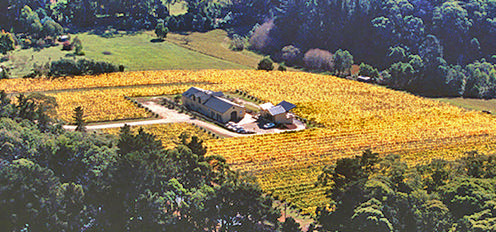
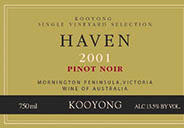 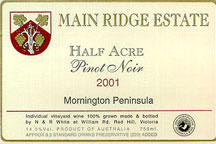 Paringa Estate: Lindsay and his son Jamie and daughter Sarah farm this small (10+-acre) vineyard. Founded in 1988, the winery produces 6,500 cases annually. Stonier Wines: Brian and Noel Stonier planted one of the pioneer vineyards of the Peninsula in 1978. The winemaker is Geraldine McFaul. The Pinot Noirs are known for fragrance, flavor and finesse. Ten Minutes by Tractor: Originally started by three family-owned vineyards, 10 minutes apart by tractor. Now owned by Martin Spedding who owns one of the three vineyards and leases the other two. 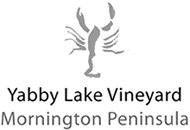 Barrymore Estate (Peter Cotter), Box Stallion Wines (Alex White), Crittenden At Dromana (Gary Crittenden), Darling Park Winery (Robert Paul), Dromana Estate (Rollo Crittenden), Elgee Park (Geraldine McFaul), Foxey’s Hangout (Tony Lee), Hickinbotham of Dromana (Andrew Hickenbotham), Hurley Vineyards (Kevin Bell), Kewleys Vineyard (Brian Kewley), Mantons Creek Vineyard, (Alex White), Marinda Park Vineyard (Sandro Mosele), Merricks Estate (Paul Evans, Alex White), Montalto Vineyard & Olive Grove (Robin Brockett), Moorooduc Estate (Richard McIntyre), Morning Star (Sandro Mosele), Myrtaceae (Julie Trueman), Osborns (Richard McIntyre), Paradigm hill (George Mihaly), Phaedrus Estate (Ewan Campbell & Maitena Zantvoort), Pier 10 (Judy Gifford), Port Phillip Estate (Sandro Mosele), Rahona Valley Vineyard (John Salmons), Red Hill Estate (Michael Kyberd), Scorpo Wines (Sandro Mosele & paul Scorpo), Seaforth Vineyard ( Phil Kittle), The Duke Vineyard (Geoff Duke), Three Wise Men (Graeme Leith). Tuck’s Ridge Winery (Michael Kyberd & Don Lewis), Willow Creek (Phil Kerney), and Winbirra Vineyard (Sandro Mosele). Beechworth Multiple varietals are planted in this hilly region from Pinot Noir to Shiraz to Nebbiolo. Availability of water can be the biggest challenge here. Giaconda: A winery of cult status in Australia. The owner is “flying winemaker” Rick Kinzbrunner. According to Andy Tan, “the most Chambolle look-alike Pinot Noirs with great purity of fruit, but not particularly age-worthy.” The Chardonnays are legendary.  Gippsland This is a very large region with many varied climates and topographies. The region is a two hour drive southeast of Melbourne in the Gippsland Mountain river-district. 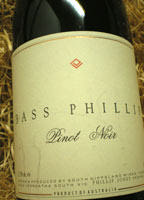 Moondara (Sandro Mosele), Philip Island (David Lance). Top Southern & Western Australia Pinot Noir Producers Southern Australia - Adelaide Hills Southern Australia is known for Rieslings, Shiraz and other Rhone-style red wines. The names Barossa, Clare Valley and McLaren Vale are magical ones for wine enthusiasts. The quality of the wines here and the plethora of food artisans and excellent restaurants appeals to travelers much like Napa/ Sonoma does to Californians. The cool Adelaide Hills region is Southern Australia’s best area for Pinot Noir. Ashton Hills (Stephen George), Barratt (Jeff Grosset), Geoff Hardy Wines (Ben Riggs), Grosset (Jeff Grosset), Knappstein Lenswood (Tim Knappstein). Western Australia This large wine-growing region has had limited success with Pinot Noir. In a cooler area such as Pemberton, for example, James Halliday notes : “The jury is still out. An enormous amount of faith has been pinned on the variety but the results have neither been convincing or consistent when used to make table wine.” Old Kent River: Established in 1985 by Mark and Debbie Novak, the wine is made under contract at Alkoomi (which produces 60,000 cases per year). Maybe the best Pinot Noir from Western Australia according to sommelier Andy Tan. Picardy: Dr Dan Pannell founded Moss Wood winery in the Margaret River region. This winery in Pemberton was subsequently chosen as a suitable site for Pinot Noir and Chardonnay. Bellarmine Wines, Salitage, Wignalls Wines Top Tasmania Pinot Noir Producers From what I read, Tasmania is Victoria’s rival when it comes to Pinot Noir. The fact that Tasmania was the source of the first vines planted in Victoria makes for some heated competition (similar to our lovehate relationship with France where our treasured vinifera vines originated). There is very little exposure of top-shelf Tasmanian Pinot Noir in the United States (it is snapped up by local islanders). The only Pinot Noir I have had is 9th Island which is made by Piper Brooks and is an inexpensive, simple Pinot Noir which one might find comparable to California Pinot Noirs on lower supermarket shelves here in California. I can only pass on what my readers and the press have said about Tasmania Pinot Noir and it has been very glowing. Tasmania has long been a source of quality grapes for sparkling wines made in mainland Australia (for example, Domaine Chandon and Southcorp). In Tasmania, there is now more Chardonnay planted than any other varietal, but there is significant acreage of Pinot Noir, Riesling and Pinot Gris. Sauvignon Blanc has shown considerable promise. Of those making Pinot Noir, the Tasmania Pinot Noir Forum acts as a unifying organization to promote and improve grape quality going back to 1999. There are 170 producers and over 100 brands of Pinot Noir in Tasmania. According to the Tasmanian government’s website, the modern age of winegrowing in Tasmania began in the 1980s with some capital-infusion from Europe. By 2006, there were 3,163 acres of vineyards. This is very small in comparison to Australia’s total output, representing less than 0.5% of the national total. It does, however, account for a higher proportion of value, because of the higher prices that grapes demand from this island state. The climate in Tasmania is varied but primarily maritime with some inland sites being warmer and more Mediterranean in nature (and conducive to Cabernet Sauvignon, Merlot and Shiraz). Pinot Noir seems to thrive in most all but the warmest parts of the island. Mark Willis, a Pinot enthusiast from Australia, notes that “If you look where it is situated, it makes total sense that Tasmania should make fantastic Pinot Noir and Chardonnay. It is truly one of the great emerging Pinot Noir regions of the world. There are stunning restaurants and it is truly one of the last great unspoiled first world regions that exist.” The first modern commercial winery on the island was Moorilla, which was started in 1958 by Claudio Alcorso, who named the winery after the Aboriginal word, “the rock by the water.” It is now owned by a syndicated company. Winemaker Andrew Hood is a central figure in Tasmania for he makes wine for at least 30 small producers. He has twice been a finalist in the Quantas/Gourmet Traveller Wine Winemaker of the Year awards. In 2003, Panorama Vineyard, south of Hobart, charged $160 for its 2001 Reserve Pinot Noir. Other producers, Domaine A and Moorilla Estate, not to be outdone, released Reserve Pinot Noirs for $100. Hefty price tags, yes, but Victoria remains the topper - 2001 Bass Phillip Reserve Pinot Noir was released at $220 a bottle. Are these prices insane?? Tamar Valley: East Arm, Holm Oak, Notley Gorge, Rutherhthe, St. Matthias, Silk Hill, Resevears Estate, Tamar Ridge Wines. Pipers River Region: Bay of Fires, Brook Eden, Dalrymple, Golders Vineyard, Pipers Brook Vineyard, ProvidenceWines. Central East Coast: Apsley George Vineyard, Spring Vale, Freycinet Vineyard (Andrew Hood). Coal River Valley: Domaine A (Peter Althaus), Wellington (Andrew Hood), Stoney Vineyard. Derwent Valley: Meadowbank Estate (Gerald Ellis), Moorilla Estate, Winstead, Stefano Lubiana (Steve Lubiana). Huron Valley (Southern): Elsewhere Vineyard, Panorama Vineyard (Michael Vishacki). 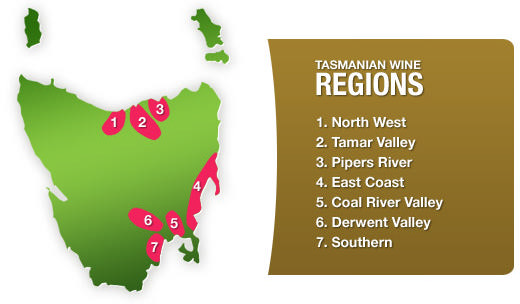
Australian Wine Dinner & TastingOn May 24, 2007, the Crew gathered at The Pacific Club of Newport Beach to sample Australian wines and Australian-themed cuisine. Master Sommelier, Rene Chazottes, planned the menu and I provided the wines. The Chef de Cuisine was David Martin. All of the wines were pre-poured in appropriate stemware (the Savaterre wines were decanted 8 hours in advance (per suggestion of Keppel Smith). None of the 15 attendees had drank Australian Pinot Noir except Rene and myself. The menu and wines are listed on the menu below. Photos of the event are on page 10. Grub Amuse Bouche, Chef’s Choice The Black Chook Sparkling Shiraz South East Australia *** Australian Yabbies a la Nage 2004 Bindi Composition Macedon Ridges, Victoria Chardonnay 2004 Kooyong Clonale Mornington Peninsula, Victoria Chardonnay 2005 Savaterre Beechworth, Victoria Chardonnay *** Rabbit in a Mustard Sauce, Fava Beans 2003 Bindi Original Vineyard Macedon Ridges, Victoria Pinot Noir 2004 Bindi Composition Macedon Ridges, Victoria Pinot Noir 2003 Moondara Conception Gippsland, Victoria Pinot Noir 2004 Yabby Lake Mornington Peninsula, Victoria Pinot Noir 2003 Eldridge Estate Clone MV6, Mornington Peninsula, Victoria Pinot Noir *** Kangaroo, Black Current Reduction, Seasonal Vegetables 2003 Kooyong Haven Mornington Peninsula, Victoria Pinot Noir 2003 Kooyong Ferrous Mornington Peninsula, Victoria Pinot Noir 2003 Kooyong Meres Mornington Peninsula, Victoria Pinot Noir 2005 Savaterre Beechworth, Victoria Pinot Noir *** Almond Fig Tart Yalumba Museum Reserve South East Australia Muscat
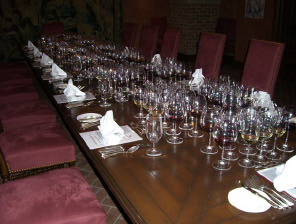
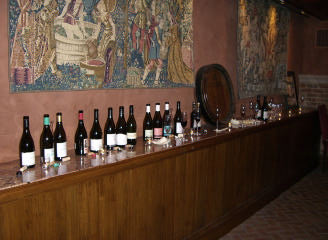
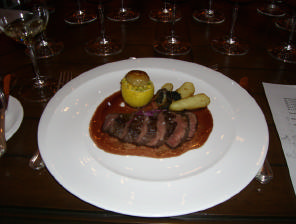
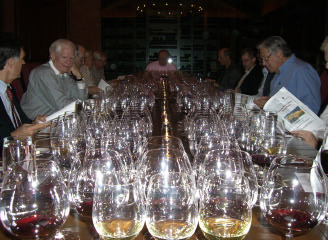 A note about Sparkling Shiraz and Muscat before discussing the other wines. Sparkling Shiraz Articles in the wine press in recent years have brought attention in the United States to Australia’s unique Sparkling Shiraz. Treasured and very popular in Australia, this sparkling wine is made in the same manner as French Champagne (methode champenoise), and is a perfect foil for Thanksgiving dinner or a summer barbecue. A Frenchman, working in Adelaide in the late 1880s, made the first commercial sparkling wine from Shiraz. The name “Sparkling Burgundy” took hold and this bold wine with a deep red color and rich flavor became very trendy in Australia. Interest waned in the 1960s when that god-awful Cold Duck, which was cheaper and sweeter, caught the fancy of the Aussies. Winemaker Warren Randall and Ian McKenzie of Seppelt Winery revived Sparkling Shiraz in 1982. Vintage Sparkling Shiraz is usually aged for five to ten years before it is released. Most examples are dry, but versions with some residual sugar are produced and are best drunk with sweeter foods like desert. There are over 60 Australian wineries producing Sparkling Shiraz today and more and more of it is being exported to the United States. My friend, Aussie David Glass, describes a favorite Sparkling Shiraz of his (Paringa) as “a bloody masterpiece of spicy fruit and dusty earthiness… .it is truly a ripper.” He advises drinking it with Thanksgiving turkey, recommending that one “stick a couple of bottles on ice… .pure magic mate!” 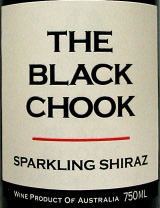 Muscat The fortified Muscats and Tokays of Australia are part of the country’s wine heritage. They are very sweet, dark, deep and “sticky.” The Muscat grapes of northern Victoria are harvested after they shrivel on the vine. No or very little fermentation is halted with the addition of pure neutral grape spirit, and the wine then ages for 1 to 100 years in very warm warehouses. The Museum release from Yalumba, Australia’s oldest family-owned winery, is a rare, reserve type release. Both older and younger wines are blended to produce a consistent style. Many fine examples of fortified wines that are exported to the United States are ridiculously cheap considering the quality (The Yalumba Muscat Museum Reserve served here was $14 for 375 ml., 18% alc.). This Muscat is really a desert in itself. We did not score the wines as is my preference, but the tasters picked their favorites. I suggested to those who were score-bound that they use the following Aussie system which employs the words the Australians use for great praise: 86 = a bottler 88 = a cracker 90 = a ripper 92 = a humdinger 94 = a corker 96 = a balltearer Chardonnays The Bindi and Kooyong Chardonnays were fine examples of the “Burgundian” style with bright minerality and wet stone accents leading the way. The Savaterre had more up front sweet fruit and butter notes with appealing oak highlights and was closer to many California-styled Chardonnays. All three were excellent and the group was split as to their favorites. The yabbies (an Australian shellfish similar to a crawfish) were a perfect match. Pinot Noirs For many tasters used to the bold fruity Caliesque Pinot Noirs, several wines were too austere (lacking Pinot extract or sappiness) and acidic (the word “sour” was bantered). I needed to remind them that Pinot Noir SHOULD have good acid - that is what makes it such a superb food companion. The clear favorites were: 2003 Eldridge Estate Single Clone MV6 Pinot Noir, 2004 Yabby Lake Pinot Noir, and 2003 Kooyong Meres Pinot Noir. My notes are as follows:
The nose is shy, even after decanting. Hi-tone cherry and rhubarb flavors are buttressed by a healthy tannic structure. Better with food than alone at this stage. A Lolita.
2004 Bindi Composition Pinot Noir 13.7% alc.. · A pure and supple wine with well-extracted cherry, raspberry and floral flavors enhanced by vanillin oak. Excellent food wine.
14.5% alc., $50. · This is berry jam on toast but with plenty of sophistication. Dark fruit driven, it is Nicely balanced and composed.
2003 Bindi Original Vineyard Pinot Noir 13.0% alc.. · Light in body, a touch of prune on the spicy nose, generous acid spine.
2003 Eldridge Estate Single Clone MV6 Pinot Noir 14.0% alc.. · A beautiful and feminine Pinot Noir with an alluring perfume of violets, roses and crushed strawberries. The lengthy finish ends with a raspberry kiss. Perfect with food.
2003 Kooyong Ferrous Pinot Noir 13.0% alc. · The darkest-colored wine in the lineup. A big wine with big fruit, big tannins and plenty of acidity. The nose is closed and the core of dark fruits is brooding.
13.0% alc.. · A red fruit panoply with nice weight and polish. The lively acidity and silky tannins lead to a clean and refreshing finish.
13.0% alc.. · The lightest-colored and most approachable of the Kooyong triad. Very charming from start to finish with bright cherry aromas and flavors, spice and everything nice. The lingering finish of spiced cherries makes your knees weak.
2003 Moondarra Conception Pinot Noir 12.5% alc.. · A bigger-styled Pinot Noir with tart black cherry and mineral flavors leading to a mouth-coating and extended finish. Lively acidity.
Additional Australian Pinot Noirs I Drank Recently2005 Eldridge Estate Red Hill Victoria Mornington Peninsula Pinot Noir 14.0% alc., screw cap. · A very accessible nose of crushed cherries, spice and a hint of toast. Soft, subtle sour cherry and tea flavors. Firm acidic background. One for the table.
2004 m.a.d. Victoria Mornington Peninsula Pinot Noir 13.5% alc.. m.a.d. is a project involving three people (Michael, Andy Tan and David) who are serious wine enthusiasts. The wine is vinified by Sandro Mosele and is sourced from selected barrels from the Ferrous Vineyard at Kooyong. The label sports an unusual (and mad) artwork from a female contemporary artist from France, Agathe de Bailliencourt, whose works are on display in the famous Comme des Garcons store in Tokyo. · This wine is crafted in the Burgundian (Gevrey-Chambertain) mold. Rich, full-bodied and exceptionally balanced. Spice (cinnamon, cardamom) infused aromatics lead to seductive flavors of plum, blackberry and a haunting earthiness. Power with elegance.
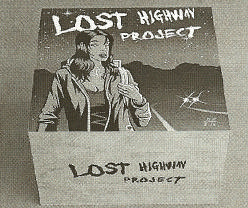 2004 Lost Highway Project (Bindi Wine Growers) Macedon Ranges Victoria Pinot Noir 14.5% alc.. Vine Street Imports (VSI), importers of fine, rare and artisan wines from around the world, collaborate with winemakers to create original and exclusive bottles with labels designed by internationally acclaimed artists. The Lost Highway Project is such a collaboration between Bindi Wine Growers, designer Justin Hampton and VSI. The wine is from a new vineyard high on the western slope of Mount Gisborne in Victoria, Australia. Each bottle is nestled in a wood silk-screened 6 pack box, with the screening featuring Hampton’s label design on the lid. · Great scent of warm cherry-rhubarb pie with notes of citrus and spearmint. Full-bodied tart red fruits in the mouth with cleansing acidity. Terrific with grilled chicken and potatoes au gratin with bacon.
1997 Scotchman’s Hill Geelong Pinot Noir 13.2% alc.. Vines planted in 1982 on top of Scotchman Hill which is an extinct volcano, becoming the second vineyard in the Geelong region and the first winery. The winery has grown to 60,000 cases annually (40% of the production in Geelong). · An aged Pinot Noir with an orange tinge to the edge. The nose has a bouquet of raisins, dried cherry and leather. The dark cherry and rhubarb flavors are quite pleasant and oak highlights are still notable. The fruit is thinning and the tannins are gossamer. Nicely balanced and a fine drink for a ten year old wine.
Food for Thought
Aussies Causing Us Grief Over a MothA tiny (6-13 mm) moth, the light brown apple moth (Epiphyas postvittana), is a native of Australia and had never been found in this country until February, 2007. when it was first discovered here in California by a retired entomologist. Now the moth has been located in nine counties, including the Napa Valley. The problem with this little bugger is that it likes to eat and is not especially picky. It will feast on numerous agricultural crops besides grapes, including apples, pears, apricots, strawberries, cabbage plants and so on. Organic pesticides have been used, traps set, and affected counties are currently under quarantine.
Prince Interviews Kangaroo for Grape RadioThe Prince could not find a suitable expert on Australian Pinot Noir in the immediate vicinity, but was fortunate to find a very helpful kangaroo. Her views of the quality of Australian Pinot Noir were a little over inflated and when I challenged her on her statements, she put on some boxing gloves. She backed down when I threatened to barbecue her for dinner. We relaxed over a glass of good Pinot.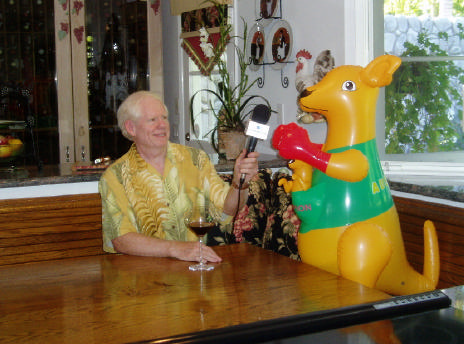
Aussie Wine DoctorsAustralian medicos have played an important role in the evolution of the country’s wine industry. Australia is unique amongst wine producing countries in that 60% of the fruit from any vintage is processed by wine companies established by Australia’s over 180 wine doctors. Australia’s three largest wine companies, Lindemans, Penfolds and Hardys, for example, were all founded by doctors as were other famous Australian labels such as Angoves, Stanley and Houghton. Wine was used as a medicine during the 1700s on the voyages to Australia from Northern Europe to prevent malnutrition and disease. The turning point in the medical treatment of convicts during transportation came in 1814, with the voyage of the Surrey. The Surrey had on board 200 male convicts, marine guards and crew. The convict’s cells below deck were poorly ventilated and not properly cleaned or fumigated. Governor Macquarie ordered an inquiry into the high death toll during the voyage of the Surrey. He appointed Dr. William Redfern, Sydney’s leading doctor, to investigate. Redfern later established a vineyard at Campbellfields, in the southwest area of Sydney in 1818, becoming Australia’s first wine doctor. Redfern was also an ex-convict. His investigations and recommendations were to have a significant impact on the Australian wine industry. He found that the captain had withheld rations from the convicts, including their wine rations. As a result, the convicts became weak and susceptible to disease. Redfern’s recommendations included a quarter pint of wine, with added lime juice, to be given to each convict every day to prevent malnutrition and scurvy. He also recommended that each transport ship have a qualified doctor on board. As a result, Australia found itself host to many naval surgeons doing convict transport. These doctors knew the health benefits of wine. Only the poorer quality wines were ever shipped to Australia. The better European wines were kept back by English wine merchants. After spending six months in a leaking oak cask in the bilge of a transport ship, the wine was frequently oxidized and contaminated with sea water. This led many doctors that had retired to Australia to establish vineyards of their own to avoid the problems associated with transporting wine to Australia and to provide wine as a medicine for their patients. The Australian medical profession’s symbol should not be the traditional snake caduceus, but a glass of wine and a convict’s leg iron, for Australia’s medical profession began with convict transport doctors attempting to maintain their convict patients’ health with wine. 
VegemiteThe Aussies have a peculiar likening for a spread from Kraft called Vegemite. Launched in 1923, as a nutritious paste made from the yeast extract left over from the manufacture of beer, it is wildly popular and sales are over 22 million jars a year. The product is banned from importation to the United States because it contains folate which is only permitted by the FDA in breads and cereals. Expatriates have been able to bring a few jars into the country for personal use, but not without much consternation created by border agents who inquisitively inspect it.
More Reading on Australian WineOz Clarke’s Australian Wine Companion, Oz Clarke, Harcourt, Inc., New York, 2004, paperback, 168 pp, $19.95. As the subtitle states, “An Essential Guide for all Lovers of Australian Wine,” this is a first-rate volume on the many wines and producers throughout Australian There are succinct overviews of the different wine producing regions, lists of classic wines to try from each region, and short summaries of the major producers including many colorful reproductions of labels. Australia’s Liquid Gold, Nicholas Faith, Mitchell Beazley, 2003, paperback, 272 pp, $29.95. An account of the growth of the Australian wine industry from its origins to the present day. Included are tales of pioneering wine doctors of the 1800s who grew grapes in Australia. 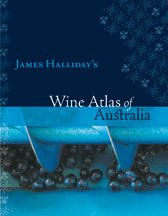 |